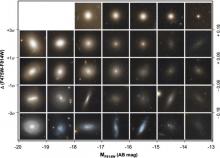
Abstract
The Coma cluster, Abell 1656, was the target of a HST-ACS Treasury program designed for deep imaging in the F475W and F814W passbands. Although our survey was interrupted by the ACS instrument failure in early 2007, the partially-completed survey still covers ~50% of the core high-density region in Coma. Observations were performed for twenty-five fields with a total coverage area of 274 arcmin^2, and extend over a wide range of cluster-centric radii (~1.75 Mpc or 1 deg). The majority of the fields are located near the core region of Coma (19/25 pointings) with six additional fields in the south-west region of the cluster. In this paper we present SExtractor source catalogs generated from the processed images, including a detailed description of the methodology used for object detection and photometry, the subtraction of bright galaxies to measure faint underlying objects, and the use of simulations to assess the photometric accuracy and completeness of our catalogs. We also use simulations to perform aperture corrections for the SExtractor Kron magnitudes based only on the measured source flux and its half-light radius. We have performed photometry for ~76,000 objects that consist of roughly equal numbers of extended galaxies and unresolved objects. Approximately two-thirds of all detections are brighter than F814W=26.5 mag (AB), which corresponds to the 10 sigma point-source detection limit. We estimate that Coma members are 5-10% of the source detections, including a large population of compact objects (primarily GCs, but also cEs and UCDs), and a wide variety of extended galaxies from cD galaxies to dwarf low surface brightness galaxies. The initial data release for the HST-ACS Coma Treasury program was made available to the public in August 2008. The images and catalogs described in this study relate to our second data release.